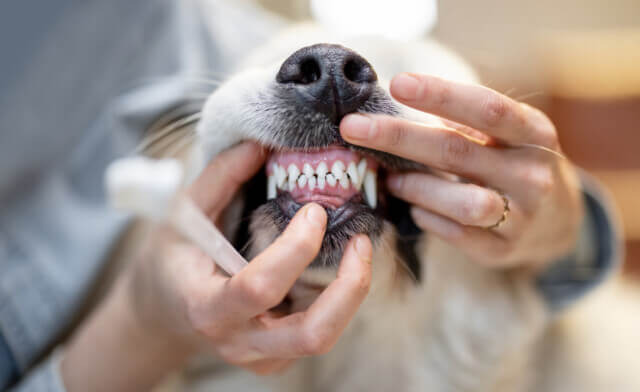How Often Should I Feed My Dog to Help Them Lose Weight?
If you’re the pet parent of a dog that’s gained too much weight, you may be wondering what you can do to control the situation and get their health back on track. While exercise can play an important role in weight loss, it’s also vital to make changes to your furry friend’s diet to help them lose those extra pounds.
In this article, we’ll take a look at how to tell if your dog is overweight and how to calculate how much to feed them. We’ll also share some tips for helping dogs of all ages get back to a healthy weight. Plus, you’ll discover how to create a feeding schedule, the best foods to feed your pup, and a whole lot more. So, let’s get started!

How Overweight Is Your Dog?
Before making any changes to a dog diet, it’s important to know your pup’s ideal weight. One way to get a good idea of your dog’s target weight is by using a weight calculator. These handy tools calculate your dog’s ideal weight, based on factors including their age, breed, and body condition.
Make sure to consult with your veterinarian after using a dog weight calculator. They will be able to confirm the results, and if necessary, provide guidance on how to help your four-legged friend safely lose weight.
Do You Have a Small or Large Dog?
Wondering how much to feed a small dog to help them lose weight? Or maybe you’re considering how much to feed a large breed puppy that’s gained a few extra pounds? With so many different types and sizes of dogs out there, it can be tricky to know where to start.
If you have a puppy, it’s important to be able to make accurate calculations about how much to feed them. After all, puppies need more calories than adult dogs to help them grow and develop properly.
A small dog weight chart or puppy growth chart can be a helpful tool when trying to determine the calorie needs of your puppy. These charts give you an idea of how big your pup will eventually get and can help you make informed decisions about their diet.
When it comes to large dogs, they generally need more food than smaller breeds. This is because they have higher energy needs and burn through calories more quickly. You’ll need to take this into account when creating a weight loss plan for your large breed dog.
Of course, every dog is different, and some may require a slightly higher or lower calorie intake. If you’re unsure how much food to feed your dog, it’s best to talk to your veterinarian. They can help you create a personalized feeding plan based on your dog’s specific needs.
Is Your Dog Older?
Age is another important factor to consider when determining how much to feed your dog to help them lose weight. Older dogs tend to have lower energy needs and may not require as many calories as younger dogs.
Most dogs over the age of one can be fed adult dog food. But how much and how often to feed adult dog food will depend on your dog’s individual needs. If they’re overweight, work with your vet to create a weight loss plan that includes a reduced calorie diet.
If you’re feeding an older dog, they may need senior dog food. These foods are designed to meet the needs of aging dogs and can help with weight management. Again, it’s best to speak to your veterinarian about the best food and weight loss plan for your older dog.
Is Your Dog a Puppy?
If you have a puppy, you’ll need to make sure they’re getting enough calories to support their growth and development. This is why it’s best to feed puppies specially formulated puppy food. Your vet can help you manage your puppy’s weight if they start to put on too much.
Puppy feeding times are also important to consider. Puppies should be fed small meals several times a day, rather than one large meal. This is because their stomachs are smaller and can’t hold as much food.
A good feeding schedule for puppies is three to four times a day. Puppies under the age of six months should be fed every few hours. As they get older, you can start to space out their meals and eventually transition to two meals a day.
Have You Tried a Feeding Schedule?
Using a dog feeding schedule is a great way to help your furry friend lose weight. This involves planning what times your dog should eat and how much food they need at each meal.
Creating a feeding schedule can help you better control your dog’s calorie intake and make sure they’re getting the nutrients they need. It can also help to prevent overeating and weight gain. Try using a dog feeding guide calculator to help you plan your pup’s meals.
A typical dog schedule would involve two meals a day, with breakfast and dinner being the most common times to feed. Of course, this may vary depending on your dog’s individual needs. For example, some dogs may do better with smaller meals spaced out throughout the day.

How Often Do You Feed Your Dog?
The frequency of your dog’s meals will also play a role in their weight loss plan. Smaller, more frequent meals can help to control your dog’s calorie intake and prevent overeating. However, feeding dogs once a day is generally not recommended, unless your vet advises it.
Consult a dog feeding chart to get an idea of how much and how often you should be feeding your pup. This will depend on their age, weight, and activity level. You should also avoid leaving food out for dogs, as this can lead to overeating and weight gain.
Have You Tried Low-Calorie Options?
If you’ve followed the tips above and your dog is still struggling to lose weight, it’s a good idea to feed low-calorie snacks such as pet-safe fruits and vegetables. These can help to fill your dog up without providing too many calories.
To keep your dog’s regular meals low in calories, you can also try using a dog food calorie calculator. This can help you determine how many calories are in your dog’s food and make sure they’re not eating too much.
A canine calorie calculator can help you to determine how many calories your dog needs based on their weight and activity level. This is a helpful tool when deciding on calorie intake for dogs.
Do You Use Portions?
Dog food portion size is also an important consideration when trying to help your dog lose weight. It’s best to measure out your dog’s food so you know exactly how much they’re eating. This can help you to ensure they’re not overeating and prevent weight gain.
Check the packaging of your dog’s food to see how much they should be eating each day. Most manufacturers will include a dog food portion chart on the back of the bag. This will tell you how many cups or ounces of food your dog needs per day, based on their weight.
Have You Tried Grain-Free Options?
If your dog is struggling to lose weight, you may want to consider switching to a grain-free diet. Grain-free dog foods are often lower in calories and fat than regular dog foods. They can also be easier for dogs to digest.
If you decide to switch your dog to a grain-free diet, make sure to do so gradually. It’s also a good idea to talk to your veterinarian first to make sure a grain-free diet is right for your dog.
Mixing grain-free and regular dog food is a good way to transition your pup to a grain-free diet. Start by mixing a small amount of grain-free food in with their regular food. Slowly increase the amount of grain-free food over time until they’re eating a purely grain-free diet.
Have You Changed Their Feeding Times?
If you’ve taken the tips in this article onboard so far, you should have a good idea of how often to feed your dog to help them lose weight. But the timing of their meals can also make a difference.
Try to space your dog’s meals out evenly throughout the day. This will help to control their calorie intake and prevent overeating. It’s also a good idea to avoid feeding your dog right before bedtime, as this can lead to weight gain and indigestion.
So, how long does it take for dogs to digest food? In general, it takes around six to eight hours for dogs to digest food. However, this can vary depending on the type of food your dog is eating and their individual digestive system.
As mentioned earlier, feeding time for puppies is different from adult dogs. Puppies usually eat three to four times a day, while adult dogs do best with two meals per day.

Have You Asked for Recommendations?
If you’re still not sure how often to feed your dog to help them lose weight, make sure to talk to your veterinarian. They can help you create a feeding schedule and weight loss plan that’s right for your dog.
Your veterinarian can also help you choose a good quality puppy food or a healthy diet food for dogs. This is important, as feeding your dog the wrong food can make it difficult for them to lose weight, even if you’re following a proper feeding schedule.
When in doubt, ask your veterinarian for recommendations on how often to feed your dog and what type of food is best for their diet. With their help, you can get your pup on the path to a healthy weight in no time!
Have You Cut Down Sugar, Fats, and Salt?
Feeding your dog the right foods to help them lose weight means cutting out sugary, fatty, and salty foods. These types of foods can lead to weight gain in dogs, as well as health problems like diabetes and heart disease.
You should also avoid feeding your dog table scraps. While you may think they’re just getting a little treat, table scraps are often high in calories and fat. As mentioned earlier, healthy foods to feed your dog include pet-safe fruits and vegetables. These are a much better option than table scraps when it comes to treats!
Have You Tried Fresh Products?
Fresh, homemade meals are always a good option when it comes to feeding your dog. If you’re not sure how to cook for your dog, there are plenty of recipes available online. Just make sure to use fresh, pet-safe ingredients and avoid adding any salt, sugar, or fat to their food.
A homemade dog food calculator can help you create a balanced meal for your pup. You can also ask your vet or a qualified animal nutritionist for help with ingredient recommendations and portion sizes.
When combined with high-quality commercial dog foods, fresh, homemade meals are a great way to add variety to your dog’s diet and help them lose weight. They’re also a healthy and delicious way to show your pup some extra love!




